
The Recipe – Old World Cabbage Rolls
The recipe’s secret step is simmering the cabbage leaves on a bed of sauerkraut.
Ingredients
- 1 1/2 pounds lean ground beef
- 1 medium-sized onion, finely chopped
- 1 cup cooked rice
- 1/2 teaspoon salt
- 1/4 teaspoon each of pepper and paprika
- 1/4 cup tomato ketchup
- 1 clove garlic, minced or pressed
- 1/8 teaspoon liquid hot pepper seasoning
- 1 large cabbage
- A large kettle of boiling, salted water
- 1 quart sauerkraut, well drained
- 1 pound kielbasa, cut In 1-lnch pieces
- 1 can (8 oz.) tomato sauce
In a wide frying pan over medium heat, brown the beef, then add the onion and cook until the onion is limp. Spoon off any fat. Stir in the rice, salt, pepper, paprika, tomato ketchup, garlic, and hot pepper seasoning. Then, remove the fry pan from the heat.
Core the cabbage, separate the leaves, and cut off the thickest portion of the central rib from 16 large leaves. (You can save the remaining cabbage for other uses.) Place and soak the leaves in the large kettle of boiling, salted water just long enough to blanch and soften them, about 1 minute. Drain the leaves.
In a 4-quart casserole, make a layer of half of the sauerkraut. Place about 1/4 cup of the meat mixture at one end of each cabbage leaf, then fold the edges of the leaf over the meat, tuck in the end, and roll up the leaf. As each roll is prepared, place it on the sauerkraut, seam side down, in a single layer.
Spoon any remaining meat mixture over the cabbage rolls, then add the remaining sauerkraut, sausage, and tomato sauce. Cover and bake in a 350° oven for about 1 1/2 hours, or until the mixture is steamy throughout and flavors are well blended. Makes 8 servings.
Mr. Darko published his “Charlie’s Cabbage Rolls” recipe in Sunset magazine in 1977. The reference is below.
Welcome to the Neuroscience Research and Development Consultancy website. Have a question or a comment? Send it to us at: Comment@NeuroSciRandD.com
In Service to Our Readers’ Convenience
Many of our readers commented that, just like all the other recipe sites, we put a lot of our personal story text first and then the reader finally gets to the actual recipe. We know. That’s so that the reader has to spend more time on their page, boosting the page up in the rankings. We are not particularly page-ranking-oriented. So, despite the fact that we do think our story’s interesting, we moved the recipe to the top of the page. People who just want the recipe have the recipe. Those who like stories and want to read on, can do so. And, of course, that makes us happy.
Old World Cabbage Rolls from the Austro-Hungarian Empire
Dr. Darko’s grandparents emigrated to the U.S. from the Austro-Hungarian Empire in 1907. This genuine union between the Austrian Empire and the Kingdom of Hungary was one of Europe’s major powers in the late 1800s and the second largest country in Europe after the Russian Empire. It was dissolved at the end of World War I. Their homeland gone, they were never able to return. This old world cabbage rolls recipe is straight from their Austro-Hungarian kitchen circa 1900.
A Cooking Tradition Lives On – Old World Cabbage Rolls
Their son, Charles Darko, grew up with his mother’s recipes and cooking straight from the historic old Empire. His parents cabbage roll dish was one of his favorites. We bring you a traditional meal from the 1900 heart of Eastern Europe.
One of our readers in Toledo, Ohio commented:
If this is a family recipe there must be more. A woman immigrant from the Austro-Hungarian Empire would not come to the United States and cook just one dish.
A perceptive observation. There are more. Others have not yet been posted on the website, but the plan is to put them here eventually. This one was chosen first as it was a favorite of Charles Darko and was published in Sunset magazine in 1977 (reference below).

Here Are Three Hungarian Chefs You Might Find Interesting
Eszter Palágyi
In 2016 Eszter Palágyi won the Chef of the Year award granted by Hungary’s Dining Guide. She is seen as the leader in a movement to make Hungarian cuisine “lighter” than the traditional meat-based goulashes and rich cream-based soups. It’s a movement toward a new Hungarian cookery. She moved a restaurant forward in Budapest to win a Michelin star in 2010, the first Hungarian restaurant to win one. She goes with seasonal recipes to follow the produce of each season, a tradition that flows from growing up in her grandmother’s kitchen. She began her studies in a culinary school in Budapest, then went on to the Mount Falcon Country House Hotel in Ireland to train further. Here’s a link to an interview with Eszter Palágyi published in luxurious magazine.

Ádám Mészáros
Ádám Mészáros is a true Hungarian, born in Budapest and at a young age became interested in cooking. At age 14 he went to the Gundel Károly Secondary School, and, after graduation, went on to the Vocational School of Hospitality to make his interest in cooking into his career. After graduation he worked in several prominent restaurants in Budapest, learning more as he pursued his career. He’s married and has two children. If you’re interested, here’s a recipe of his that was published in Four Recipe Magazine, the October 20, 2018 issue. It’s Ádám Mészáros’ Saddle of Lamb with Fondant Potato and Summer Truffle recipe. The result is said to be perfectly pink lamb, luscious fondant potato, and scrumptious truffle.
Ákos Sárközi

A common history of these Hungarian chefs is that their interest in cooking started with learning from their mother, and this is again true of Ákos Sárközi. His higher aspirations came after years as working as “just a chef”. Then he got a position at Alabárdos, an extraordinary restaurant in Budapest that food lovers describe with the highest praise. Suddenly he found himself in the rich atmosphere of top-level gastronomy. This whole new world of cuisine was wonderful for him personally and for his career development. In 2022 received the Best Chef Award, putting him permanently on the map.
Publication Reference
Sunset (Desert Edition), Vol. 159, No. 3, September 1977, p. 142.
